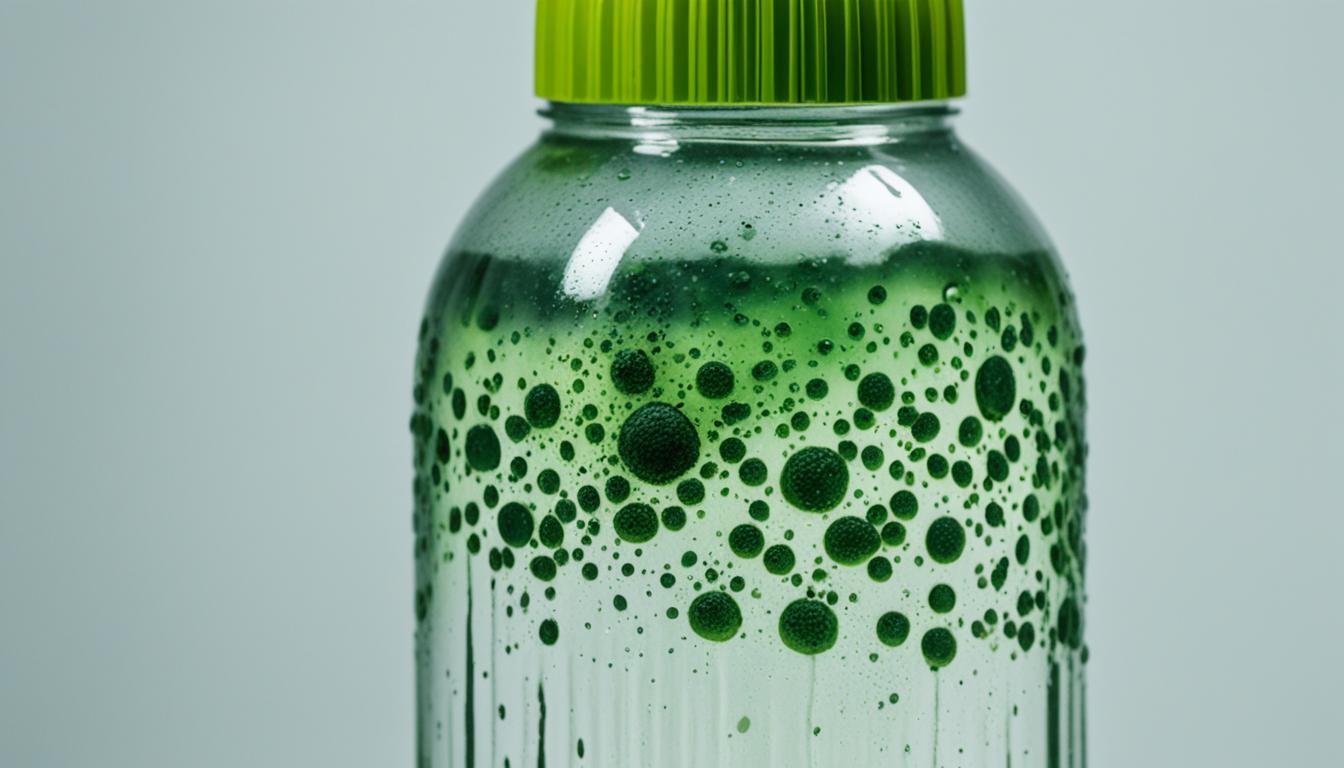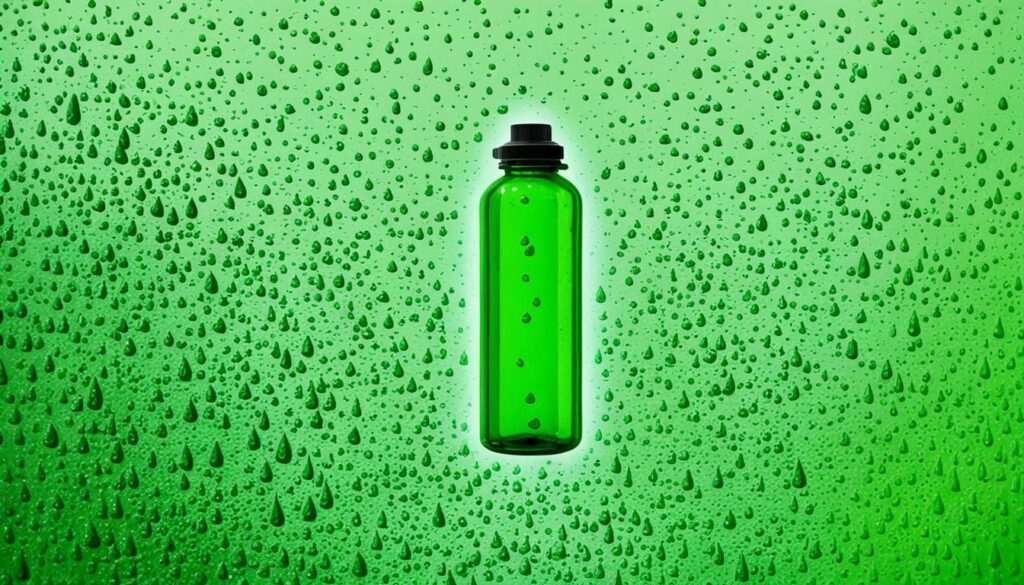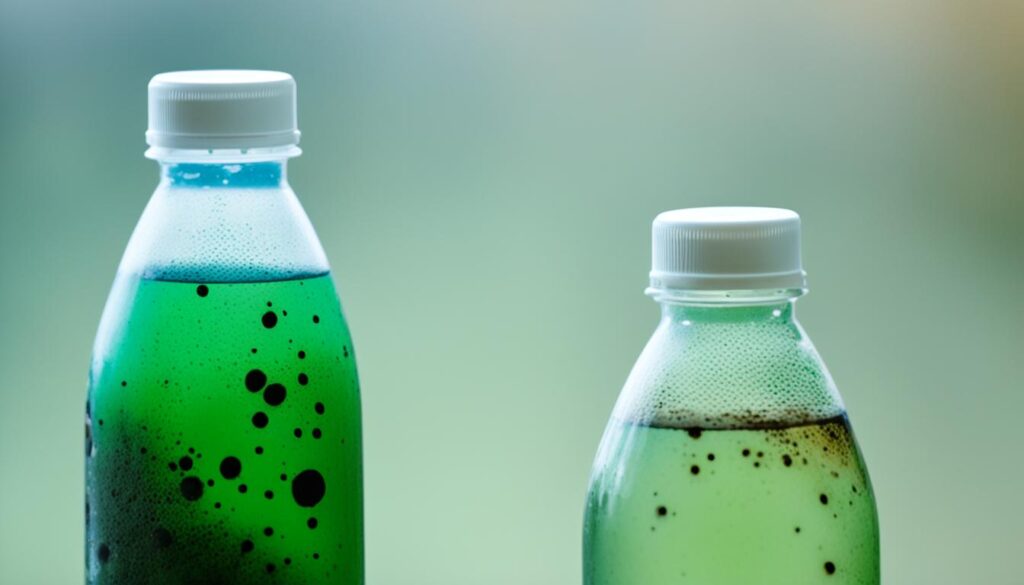
The Complete Guide to Mold in water bottle
Water bottles have become an essential part of our daily lives, helping us stay hydrated on the go. However, what many people may not realize is that these seemingly harmless containers can become a breeding ground for mold if not properly maintained. In this guide, we will explore the prevention of mold growth, safe cleaning methods, and the potential health implications of using water bottles contaminated with mold.
Key Takeaways:
- Mold in water bottles can pose health risks and should be prevented.
- Proper hygiene practices, including regular cleaning and drying, can help prevent mold growth.
- Safe cleaning techniques using vinegar, bleach, or antimicrobial solutions should be employed for moldy water bottles.
- Mold exposure can lead to allergies, respiratory problems, and the presence of harmful mycotoxins.
- Promptly addressing mold issues is crucial for overall health and well-being.
Understanding Mold in Water Bottles
Mold growth in water bottles can be a common problem, posing potential health risks and compromising the safety of your drinking water. To effectively address this issue, it is essential to understand the science behind mold formation and the factors that contribute to its growth.
Mold is a type of fungus that thrives in moist environments and can easily develop in water bottles if not properly cleaned and dried. It reproduces by releasing spores into the air, which can cause allergic reactions and respiratory problems when inhaled. Microorganisms, such as bacteria and yeast, play a crucial role in the initial formation of mold by breaking down organic matter, creating a suitable environment for mold growth.
The presence of moisture in water bottles is a primary catalyst for mold development. When moisture is trapped inside a bottle, whether from inadequate drying or improper storage, it creates an ideal breeding ground for mold spores to proliferate and form visible colonies. This is why it is crucial to ensure water bottles are thoroughly dried after each use and stored in a well-ventilated area to minimize moisture accumulation.
“When it comes to mold growth in water bottles, prevention is key. By understanding the conditions conducive to mold formation and taking proactive measures to address them, you can maintain a safe and mold-free drinking experience.”
Factors Contributing to Mold Growth in Water Bottles
Several factors can contribute to the growth of mold in water bottles:
- Lack of proper cleaning: Residual organic matter, such as food particles or bacteria, can provide nourishment for mold spores. Without regular and thorough cleaning, these contaminants can accumulate and facilitate mold growth.
- Prolonged exposure to moisture: Leaving an empty water bottle with trapped moisture for an extended period can create an environment that promotes mold growth. Empty bottles should be promptly emptied, rinsed, and thoroughly dried to prevent mold formation.
- Improper storage: Storing water bottles in dark and damp places, such as gym bags or cars, can increase the likelihood of mold growth. Optimal storage involves keeping bottles clean, dry, and in well-ventilated areas to discourage mold spores from taking hold.

Preventing Mold in Water Bottles
Proper prevention techniques are essential in avoiding mold growth in water bottles. By practicing good hygiene, implementing regular cleaning routines, and ensuring thorough drying, you can significantly reduce the risk of mold formation. Here are some practical tips to help you prevent mold in your water bottles:
1. Practice Proper Hygiene
Regularly clean your water bottle to maintain proper hygiene and prevent mold growth. Make sure to follow these steps:
- After each use, rinse your water bottle with warm water.
- Use a bottle brush or a sponge with hot, soapy water to scrub the inside of the bottle.
- Rinse the bottle thoroughly to remove all soap residue.
- Allow the bottle to air dry completely before using or storing it.
2. Ensure Thorough Drying
Drying your water bottle properly is crucial to prevent moisture accumulation, which can lead to mold growth. Follow these drying techniques:
After washing your water bottle, place it upside down on a clean dish rack or a drying mat. This allows air to circulate inside the bottle, ensuring thorough drying. Avoid using towels or cloths to dry the bottle, as they can introduce additional moisture.
3. Store Your Water Bottles Properly
Proper storage is essential in preventing mold formation in water bottles. Consider the following recommendations:
- Store your water bottles in a cool, dry place.
- Avoid storing bottles in damp environments, such as basements or bathrooms.
- Do not seal the water bottle with the cap when it is not in use. Leave it open to allow air circulation.
To further understand the importance of prevention, let’s take a look at the potential health risks associated with mold in water bottles.

In the next section, we will explore the health implications of mold in water bottles and why it’s crucial to address this issue promptly.
Safe Cleaning Techniques for Moldy Water Bottles
When it comes to dealing with mold in water bottles, safe cleaning techniques are crucial to ensure the complete removal of mold and the prevention of recontamination. In this section, we will discuss various effective methods using household ingredients like vinegar and bleach, as well as commercially available antimicrobial solutions.
1. Vinegar Cleaning Solution
Vinegar is a natural and safe cleaning agent with antimicrobial properties that can help eliminate mold from water bottles.
- Fill the water bottle with equal parts white vinegar and water.
- Let the solution sit in the bottle for at least 30 minutes to an hour.
- Afterward, scrub the bottle thoroughly with a bottle brush, paying extra attention to any visible mold spots.
- Rinse the bottle with clean water to remove any vinegar residue.
- Allow the bottle to air dry completely before using it again.
2. Bleach Cleaning Solution
Bleach is a strong disinfectant that can effectively kill mold spores and sanitize water bottles. However, it is important to use bleach carefully and follow safety precautions.
- Prepare a solution of one tablespoon of bleach per gallon of water.
- Fill the water bottle with the bleach solution, ensuring all surfaces come into contact with the solution.
- Let the bleach solution sit in the bottle for about 10 minutes.
- Thoroughly rinse the bottle with clean water to remove any bleach residue.
- Air dry the bottle completely before using it.
3. Antimicrobial Cleaning Solutions
If you prefer commercial cleaning products, there are various antimicrobial solutions available that specifically target mold and other microorganisms. These products typically come with user instructions, so be sure to follow them carefully for optimal results.
Remember to always wear gloves and work in a well-ventilated area when using cleaning solutions, especially bleach. It is important to avoid mixing cleaning agents, as it can produce toxic fumes.
By using these safe cleaning techniques, you can effectively eliminate mold from your water bottles and maintain a hygienic drinking vessel. Regular cleaning and proper storage are key to preventing mold growth in the future.
Health Implications of Mold in Water Bottles
Using water bottles contaminated with mold can pose significant health risks. Mold exposure can lead to a range of health problems, including allergies, respiratory issues, and the potential presence of mycotoxins.
Allergies: Mold in water bottles can trigger allergies in individuals who are sensitized to mold spores. Symptoms may include sneezing, nasal congestion, itchy or watery eyes, skin rashes, and even asthma attacks.
Respiratory Problems: Prolonged exposure to mold in water bottles can cause respiratory problems, especially in individuals with compromised immune systems or underlying respiratory conditions. This includes symptoms such as coughing, wheezing, chest tightness, and difficulty breathing.
Mycotoxins: Certain types of mold can produce mycotoxins, which are toxic substances that can cause adverse health effects when ingested or inhaled. These mycotoxins may contaminate the water inside the bottle and pose additional health risks to individuals who consume it.
It is important to address mold issues in water bottles promptly to mitigate these health risks. Regularly inspecting and cleaning water bottles, as well as following proper storage and drying practices, can help prevent mold growth and maintain a safe drinking environment.
The Importance of Prompt Action
Addressing mold in water bottles is crucial for maintaining overall health and well-being. Ignoring the presence of mold can lead to a worsening of symptoms and potentially more severe health complications.
“Mold growth in water bottles should never be taken lightly. It is essential to address the issue promptly to prevent any potential health risks associated with mold exposure.” – Dr. Jennifer Thompson, Environmental Health Specialist
By understanding the health implications and taking proactive measures to prevent and eliminate mold in water bottles, individuals can ensure the safety of their drinking water and protect their health.
Stay tuned for the conclusion of our Complete Guide to Mold in Water Bottles, where we will summarize the key points discussed and provide final recommendations for maintaining a mold-free water bottle.
Conclusion
In conclusion, addressing mold in water bottles is essential for maintaining both our health and well-being. Throughout this guide, we have highlighted the key points to consider when dealing with mold in water bottles and provided practical tips for prevention and safe cleaning. By following these recommendations, you can ensure the safety of your drinking water and minimize the risk of mold-related health issues.
Firstly, preventing mold growth in water bottles is crucial. Practicing proper hygiene, including regular cleaning and drying, can significantly reduce the chances of mold formation. Additionally, storing your water bottles in a dry and well-ventilated area can help prevent moisture accumulation, which is a prime condition for mold growth.
If mold does appear in your water bottle, it’s important to clean it safely and effectively. There are various methods you can use, such as using vinegar or bleach, as well as commercially available antimicrobial solutions. However, always follow safety precautions and carefully read the instructions provided by the manufacturer.
Remember, mold exposure can pose serious health risks, including allergies, respiratory problems, and the presence of toxins. Therefore, it is crucial to address mold issues promptly and take necessary actions. If you are unable to clean the mold yourself or suspect a severe mold problem, it is recommended to seek professional assistance to ensure a thorough and proper cleanup.




